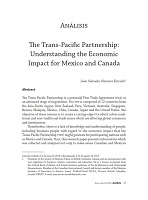The Trans-Pacific Partnership: Understanding the Economic Impact for Mexico and Canada
DOI:
https://doi.org/10.32870/mycp.v5i13.498Palabras clave:
Trans-Pacific Partnership, free trade agreement, North America, trade and investment, international economics.Resumen
The Trans-Pacific Partnership is a potential Free Trade Agreement (FTA) atan advanced stage of negotiation. The TPP is composed of 12 countries from the Asia-Pacific region: New Zealand, Peru, Vietnam, Australia, Singapore, Brunei, Malaysia, Mexico, Chile, Canada, Japan and the United States. The objective of these nations is to create a cutting-edge fta which solves tradi-tional and non-traditional trade issues which are affecting global commerceand investments.Nonetheless, there is a lack of knowledge and understanding of people, including business people with regard to the economic impact that the Trans-Pacific Partnership (TPP) might generate for participating nations such as Mexico and Canada. Thus, this research paper presents information whichwas collected and analyzed not only to make aware Canadian and Mexican business people about the relevance of the tpp, but also to encourage them to find synergies and collaborations between them. Analysis was based on secondary research, collecting information through multiple secondary datasources to provide different perspectives.The research drew attention to the fact that the tpp region might become one of the most relevant trade regions around the globe, because itwould represent an attractive market of more than 800 million consumers, representing about 40% of the Global GDP (Dawson & Bartucci, 2013: 2-4).Further investigations revealed that the economic impact of the tpp for all 12nations would be positive and based on trade creation. It is estimated that by 2025, the TPP would produce extra income in the world trade of 295 billion USD (Petri, Plummer & Zhai, 2012: 85). In the particular case of Canada and Mexico, economists have pointed out that by 2025, Mexico could receive sub-stantial benefits from the tpp, gaining 21 billion usd in additional income, whereas Canada would also gain extra income, about 9.9 billion usd (Petriet al., 2012: 40-44).Finally, this research paper states five recommendations for Canadianand Mexican business people to increase their knowledge and understandingof the TPP and they contribute to get the benefits when this FTA is in force. El Acuerdo de Asociación Transpacífico: entendiendo el impacto económico para México y Canadá. El Acuerdo de Asociación Transpacífico(TPP) es un potencial acuerdo de libre comercio (TLC) que se encuentra en una etapa avanzada de negociación. El TPP está integrado por 12 países de la región Asia-Pacífico: Nueva Zelanda, Perú, Vietnam, Australia, Singapur, Brunei, Malasia, México, Chile, Canadá, Japón y Estados Unidos. El objetivo de estas naciones es crear un acuerdo de libre comercio de vanguardia que resuelva cuestiones comerciales tradicionales y no tradicionales que están afectando el comercio y las inversiones a nivel mundial. No obstante la relevancia del TPP, hay una falta de conocimiento y comprensión entre la población, incluida la gente de negocios en relación con el impacto económico que este acuerdo comercial podría generar para los países participantes como México y Canadá. De tal manera, este trabajo de investigación presenta información no sólo para hacer conscientes a los empresarios canadienses y mexicanos sobre la relevancia del TPP, sino también para animarles a encontrar sinergias y colaboraciones entre ellos. La investigación puso de relieve que el TPP podría convertirse en una de las regiones comerciales más relevantes de todo el mundo, ya que representaría un atractivo mercado compuesto por una población de más de 800 millones de consumidores y que representa cerca de 40% del PIB mundial (Dawson y Bartucci, 2013: 2-4). Otras investigaciones revelaron que el impacto económico del TPP para las 12 naciones participantes sería positivo, basado en la creación de comercio. Se estima que para el año 2025 el tpp produciría un ingreso mundial adicional de 295 billones de dólares (Petri, Plummer y Zhai, 2012: 85). En el caso particular de Canadá y México, los economistas han señalado que en el año 2025 México podría recibir beneficios sustanciales a través del tpp, ganando 21 mil millones de dólares en ingresos adicionales, mientras que Canadá también ganaría un ingreso extra equivalente a 9,900 millones de dólares (Petri et al., 2012: 40-44). Finalmente, en esta investigación se establecen cinco recomendaciones para que empresarios canadienses y mexicanos sigan incrementando su conocimiento y comprensión sobre el TPP y contribuyan a obtener los beneficios de este acuerdo comercial cuando éste entre en vigor.Descargas

Descargas
Publicado
Número
Sección
Licencia
Política de acceso abierto
Esta revista proporciona un acceso abierto a su contenido, fiel al principio de que ofrecer al público un acceso libre a las investigaciones ayuda a un mayor intercambio global del conocimiento.
MyCP se publica bajo la licencia de Creative Commons Reconocimiento-No Comercial CC BY-NC
Los contenidos serán publicados en versión PDF y XML.
Los autores(as) que publiquen en México y la Cuenca del Pacífico aceptan las siguientes condiciones:
De acuerdo con la legislación de derechos de autor, México y la Cuenca del Pacífico reconoce y respeta el derecho moral de los autores(as), así como la titularidad del derecho patrimonial, mismo que será cedido a la Universidad de Guadalajara para su difusión en acceso abierto.
México y la Cuenca del Pacífico no realiza cargos a los autores(as) por enviar y procesar artículos para su publicación.
Los autores(as) pueden realizar otros acuerdos contractuales independientes y adicionales para la distribución no exclusiva de la versión del artículo publicado en México y la Cuenca del Pacífico (por ejemplo, incluirlo en un repositorio institucional o darlo a conocer en otros medios en papel o electrónicos) siempre que indique clara y explícitamente que el trabajo se publicó por primera vez en México y la Cuenca del Pacífico.
Una vez que se acepte el artículo para su publicación los autores(as) deben remitir el formato de carta-cesión de derechos de la publicación debidamente requisitado y firmado por los autores(as). Este formato debe ser remitido en archivo PDF paralelamente con la versión final del artículo al correo: mexicoylacuenca@gmail.com.
Los lectores/usuarios de México y la Cuenca del Pacífico pueden acceder directamente al contenido de manera libre y gratuita en todo momento, incluyendo cuando un nuevo número es colocado en la plataforma. Se permite al lector/usuario citar, compartir (electrónicamente y de manera física), imprimir y distribuir el material siempre que se indique de manera clara y explícitamente que el trabajo se publicó por primera vez en México y la Cuenca del Pacífico. Es necesario citar de manera correcta el trabajo y no debe de ser utilizado con fines comerciales.




